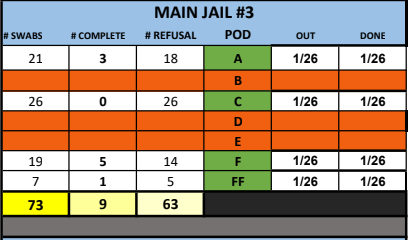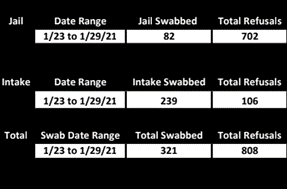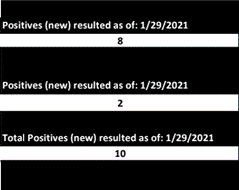
The Covid In-Custody Project partners with the Davis Vanguard to bring quantitative and qualitative reporting on the pandemic’s impact on county jails and CDCR to the public eye. This story is authored by the Covid In-Custody team.
By Ned Meiners
In February of this year Fresno County Jail (FCJ) made national headlines. As of February 1, nearly eleven months into the pandemic, the jail had reported more COVID-19 infections than any correctional facility in the nation.
Jail officials attempted to explain the number of infections, which totaled 3,814, by highlighting rigorous testing at the facility. “We’ve been really aggressive with our testing at the Fresno County Jail,” stated Fresno County Sheriff Margaret Mims.
However, for observers monitoring COVID-19 data in California’s prisons and jails, this was news. For months FCJ had scarcely reported any numbers to the media or state agencies. This lack of transparency was concerning and cast doubt on how the institution was handling the pandemic.
Accurate data is a valuable tool in fighting the pandemic when the consequences can be deadly. As of January 2021, FCJ is the only county jail in Northern California that has reported a COVID-related death.
“It Stirs Up Hysteria When Things Become So Data Driven”
According to Fresno County Public Defender Elizabeth Diaz, the Sheriff’s Office provides her office with information about COVID-19 cases at FCJ, however only when prompted. “We ask the question and we get the answers. It’s not necessarily forthcoming,” explained Diaz to KQED last August.
For the Covid In-Custody Project and other observers, access to regular data has been a struggle throughout the pandemic.
Fresno County Sheriff’s Office Public Information Officer Tony Botti was blunt when explaining why data was not forthcoming. “It stirs up hysteria when things become so data driven.” wrote Botti in a July 21 memo.
This contrasts dramatically with the advice of medical professionals and public health experts. According to Dr. Brie Williams, Professor of Medicine at the University of California San Francisco, “Without accurate, timely and comprehensive data about the impact of COVID-19 in prisons, we are at an extraordinary disadvantage in the fight to keep people who live or work in prisons and their surrounding communities safe from the pandemic.”
Unlike California’s prisons, which are all overseen by the California Department of Corrections (CDCR), California’s jails are run by the Sheriff’s Office of the county in which they reside. Data reporting is at the discretion of the local Sheriff— there is no statewide mandate for Sheriff’s Offices to report cases, testing, vaccination rates, etc. for their jails.
While the California Department of Public Health (CDPH) collects information from the counties through the California Reportable Disease Information Exchange (CalREDIE), they do not publish it because it is unreliable and incomplete.
In July 2020, the Board of State and Community Corrections (BSCC) made an urgent request to the Sheriffs and Chief Probation Officers to provide facility level COVID-19 data directly to them. While some Sheriffs chose to honor BSCC’s request, many did not. Often the data that is provided is incomplete, erroneous and obscures the answer to a simple question like, “How many cases have been identified during the pandemic?”
Despite not having any data reporting requirements, several Bay Area counties have taken it upon themselves to be transparent. Since March 2020, Alameda County has published daily reports on the number of COVID-19 tests administered, positive cases as well as the number of people incarcerated at Santa Rita Jail.
Both San Francisco and Santa Clara counties have followed suit and share regular data with the public through the county website.
Clearly, when there is a desire to make data available to the public, jails are able to do so. As Dr. Williams stated, data is vital to not only understanding the spread of the virus in the facility, but also in the surrounding community and developing public health interventions.
To mitigate the impact of the virus, most county jails instituted some measures to reduce the jail population. In Fresno and other counties, zero bail and cite and release policies were enacted.
While some counties recorded a dip in the jail population during Spring and Summer of 2020 due to these policies, their effect in Fresno County is unknown; The Fresno County Sheriff’s Office did not report its population for this period.
In fact, since Fresno began reporting its population numbers the incarcerated population has only risen. In its first report to the BSCC on August 1, 2020, the total jail population was 2,055. As of July 15, there are 2,754 people in custody.
The BSCC Data
On July 27, 2020, the BSCC began publishing COVID-19 jail data on its website.
In addition to data reporting being voluntary, the BSCC also has no way to verify the validity or correctness of the reported numbers. In their own words, “we rely on the counties to provide accurate data as the BSCC does not have audit authority.”
Fresno County’s data reported to the BSCC has been incomplete, unnecessarily vague and lacks key data points. There is no data reported for the number of people quarantine, active cases, or any vaccination data.
If the number of confirmed cases is less than 11 for a reporting period, the exact number is not reported at all, it is simply acknowledged that there are active cases at the facility. The BSCC states that this is in accordance with public health de-identification guidelines in order to protect the identity of those tested.

However, this makes the data unusable for statistical purposes. “Since the actual values are not available, data across counties cannot be summed to obtain statewide totals. Similarly, cumulative totals within a country are not calculated,” the BSCC stated in their “COVID-19 in Adult Detention Facilities Data Reporting Guide”.
While the Covid In-Custody Project has used this data to obtain a rough estimate of COVID-19 cases in Fresno County’s jails, it is incomplete. Furthermore, the data does not cover several of the most deadly months of the pandemic.
When the Fresno Sheriff’s Office began reporting numbers to the BSCC on July 27, 2020, the jails were already in the midst of an outbreak that had begun in June, when a large group of transfers to CDCR were found to be positive for COVID-19.
On July 20, 2020 Fresno Sheriff Margaret Mims told The Fresno Bee that as of the previous Friday, July 17, there had been 764 positive COVID-19 cases at the facility, over 40 of which were correctional officers.
According to one person incarcerated at the jail, the virus was spreading throughout the facility long before Mims statement to the media. His entire 72-man pod was placed under quarantine on June 6. “My entire pod had it on the first quarantine…They left everyone there because they came and swabbed us all and we all tested positive.” he explained.
They would remain under quarantine for the next 39 days.
BSCC’s Missing Data
Without concrete data from FCJ for the worst months of the pandemic, the Covid In-Custody Project, has had to rely on statements made by jail officials to media outlets during June and July to estimate the extent of the outbreak. However, once the jail began reporting to the BSCC the data had glaring holes and inaccuracies.
Some weeks FCJ reported no data to the BSCC at all. These include:
September 6 – 12, 2020
December 27, 2020 – January 3, 2021 (missing number of positive tests)
June 6 – 12, 2021
The absence of data for these weeks is disconcerting particularly because they occur during massive outbreaks at the facility.
For the missing week in September, during the previous week, 45 out of the 132 tests administered had come back positive. The week after, September 13 – 19, there were no positive test results out of 522 tests administered.
The missing week which stretches from Dec. 2020 to Jan. 2021 is also disconcerting. This was in the middle of the most severe, and deadly, outbreak in the jail since the summer. Between December 20 – 26, there were 79 positive tests. The week after the missing data, on January 10, FCJ reported 33 positive tests.
Even more alarming, that week is when the jail reported a death at the facility due to COVID-complications. An email exchange with Botti confirmed that one individual had died but was evasive when pressed for details. “He was hospitalized and passed away during his stay.” explained the Officer.
Any follow-up questions regarding the dates of his incarceration, the dates he tested positive, or procedures surrounding hospitalization were ignored. Botti claimed that to divulge such information would be a violation of HIPAA laws. He advised filing an additional PRA request where the Sheriff’s Office would determine what information would need to be redacted.
While COVID-related deaths have occurred in jails in Los Angeles and Orange counties, the death reported on January 10 at FCJ is the only such instance at a facility in Northern California. Given the lack of transparency around COVID-19 data at the jail, the reticence of officials to explain the circumstances is not surprising, however it should be a cause for alarm.
Extreme Variations in Testing
In the data Fresno County has reported to the BSCC, there are extreme variations in weekly testing rates which casts doubt on the efficacy of the testing protocol.
For example, between August 30 – September 5, out of 132 tests administered, 45 came back positive. Two weeks later, the number of tests administered shot up to 522, but none were positive.
It seems unlikely that within a week FCJ could go from having 34 percent test positivity rate, to not having a single positive test result.
Particularly in the early weeks of data reporting, the number of tests administered showed no consistency. For example in August 2020, 114 tests were administered in a week and 721 in the next. Only in early 2021 did the testing rate stabilize to a consistent 300-400 tests per week.
Strangely in the midst of outbreaks, the number of tests administered has tended to fall. In the first week of December, FCJ reported less than 11 positive results out of 505 tests administered. By Chritmas, when the outbreak peaked, the jail had only administered 222 tests of which 79 came back positive.
Discrepancies Between BSCC Data and Media Reports
In several instances, the data reported by the Sheriff’s Office to the media and the BSCC do not align.
On September 24, 2020 Botti stated in an email to the Covid In-Custody Project that there had been a total of 3,921 tests administered at the facility since March 2020. However, the sum of testing data reported to the BSCC and obtained via data requests, it appears that as of September 19, 2020, only 4,186 tests were administered.
Similarly, on January 12 in a statement to The New York Times, Botti claimed the jail had 3,814 cases since the start of the pandemic and had administered an astonishing 34,000 tests. The sum of testing data reported to the BSCC shows that no more than 10,000 total were administered. The total number of positive test results by our estimate was 1,589.
Sheriff Mims, attempted to address these discrepancies after activist groups questioned the accuracy of the data FCJ was reporting to the BSCC. Mims claimed that although there were 3,814 positive test results in FCJ since the start of the pandemic, it does not equal the number of positive cases, since some individuals tested positive numerous times.
“During the beginning stages of the pandemic, once an inmate tested positive for COVID-19, the inmate was placed in quarantine housing. Inmates remained in quarantine housing until they had a subsequent negative covid test.” explained the Sheriff. “This resulted in inmates testing positive for a second and third time…It was relatively unknown at the time, but an inmate may continue to test positive for months, while no longer being contagious.”
According to Mims, the actual number of unique cases at FCJ between March 3, 2020, the date of the first case in the facility, and March 1, 2021 was 1,365.
While it is not unreasonable to conclude that the amount of positive test results does not equal the number of cases due to double testing, the Sheriff’s Office has provided no evidence as to how they arrived at the total of 1,365 cases.
FCJ has provided no rationale as to how they have administered 34,000 tests when the calculation shows that no more than 10,000 were given.
Public Records Request
When the numbers reported by the Fresno Sheriff’s Office to the BSCC appeared to be incomplete and inaccurate, the Covid In-Custody Project requested data from the jail under a Public Records Act (PRA) request. Under state law, government institutions must supply interested parties with publicly available records upon request.
A request was filed on January 4, 2021 to obtain data from the jail. The Covid In-Custody was met with reactions ranging from hostility to indifference from jail officials. While we requested ongoing updates on data coming from the jail, we were told each new week of testing would require a new PRA request.
According to the PRA law, once a request is filed the institution in question has 10 days to respond and confirm if the documents are available. Then, according to the California Public Utilities Commission, the request should be fulfilled in a “timely fashion.” Fresno County Jail did not fulfill its records request till May, a full five months after the data was first requested.
The data finally received were swab reports, which is the raw data the jail uses to report to the BSCC. The data is broken down by the three different buildings at the facility, and then subdivided into floors, and then each individual pod. There are five floors in the Main Jail, four in the North Jail, three in the South Jail, as well as the intake facility.



Screenshot of totals for the entire jail from swablist, for the week 1/23/-1/29 of 2021
Each week the data is reported and the totals are broken down by the number of tests administered in a pod within the jail, those administered at intake, as well as the overall total.
The swab reports also include one data point not reported to BSCC; the number of refusals to take a COVID test.
Other data from the PRA request, such as, such as vaccination data for the staff and incarcerated population, the number of people currently under quarantine, and the number of active cases, was never supplied by the authorities. The request was simply ignored despite multiple follow-ups.
Incomplete Swab Data
The data received had many holes and only covered the months of September 2020 through January 2021. Any hope that the data would shed light on testing in FCJ prior to reporting to BSCC began, particularly during the worst outbreak in July, was dashed.
The data also had a two week gap at the end of November, at a time when the BSCC showed 19 positive tests at the facility for the week of November 15-21, and 12 positive cases for the week of November 22-28.
In other parts, data was duplicated. The same swab report from the dates December 26, 2020 through January 1, 2021 was submitted on January 2 and again on January 9. Even stranger is the data showed only 11 tests administered in the jail pods for that period, but 33 positive test results.
While the Covid In-Custody Project had hoped the swab data would fill in the blanks and supplement the BSCC data, it is too incomplete to accomplish that.
Contradictions with BSCC Data
Alarmingly, the data in the swab list diverged in numerous places from data supplied to the BSCC.
A swab list from September 25, 2020, showed that 459 tests administered in the jail in one week. The data reported to the BSCC for the corresponding week lists a total of 84 tests. This type of under-reporting was common.
Between November 7-13, the swab reports showed 19 positive cases. For the same time period, “less than 11” cases were reported to the BSCC.
Other times the data reported to the BSCC seemed much more dire than that contained on the swab list. Between October 25 – 31 FCJ reported that 674 tests were administered in the jail and 21 were positive. The swab lists for the corresponding period show only three cases for 337 tests.
Testing Refusals in FCJ
A key piece of data that the swab lists shed light on is the number of refusals. As noted earlier, a surge in positive cases at FCJ was often quickly followed by a drop in the total tests administered. However, there is also a simultaneous increase in the number of individuals refusing tests.
For example, the screen capture above shows only nine completed tests and 63 refusals for a single floor of the Main Jail.
What this makes clear is that FCJ was not attempting fewer tests during outbreaks, but that incarcerated people presumably did not want to take them. Across the country, COVID-19 quarantine units have been compared to solitary confinement, causing many to decline testing to eliminate the chance of being positive.
Under quarantine, a 72-man pod will be unable to leave their area of the jail for up to or over a month. Access to amenities is curtailed. Individuals cannot see their attorneys or attend court dates, resulting in longer periods of incarceration.
“It’s like you’re damned if you do and damned if you don’t.” described one inmate. “You go over the speedy trial 90-day deadline, I saw that happen three times to one guy. Dropped him and refiled and added charges.”
If a positive COVID test can trigger a quarantine, many decide it is in their best interest not to take the test at all.
FCJ: Looking Back, Looking Forward
Without accurate data to rely on, it is impossible to understand the true scope of the pandemic in California’s jails, and how best to ensure the safety of those living there in future. The data supplied by FCJ is so incomplete, erratic and contradictory it is impossible to draw firm conclusions from it.
On several occasions, Jail officials have acknowledged that the numbers they reported were inaccurate and misleading. For example, Mims has publicly stated double-testing in the jail has been a problem and the number of unique COVID cases in the facility must be revised.
While this is an acceptable goal, there is no apparent methodology they are using to ensure an accurate total. The data they supplied to the Covid In-Custody Project certainly provides no indication. To the contrary, the totals the jail has reported differ so radically from their swab sheets, there seems to be some degree of guesswork used by the jail to arrive at official numbers.
As the spread of COVID has slowed and jails are reporting fewer cases, it is tempting to declare that the pandemic is over. The population in jails across the state is climbing steadily and attention at many institutions has turned their attention to vaccination efforts.
Again, FCJ is behind the curve in reporting the relevant data. There is currently no data available for vaccination rates at the jail. Observers must rely on media reports and rare public statements to get a glimpse of conditions inside the facility.
What is being reported does not look good; According to a local ABC affiliate, 57% of people incarcerated at the jail are refusing the vaccine.
FCJ has already seen the deadly consequences of haphazard testing and reporting at the facility and made no efforts to revise or improve its protocols. Should infection rates begin to rise again, that could spell danger for the people incarcerated there.